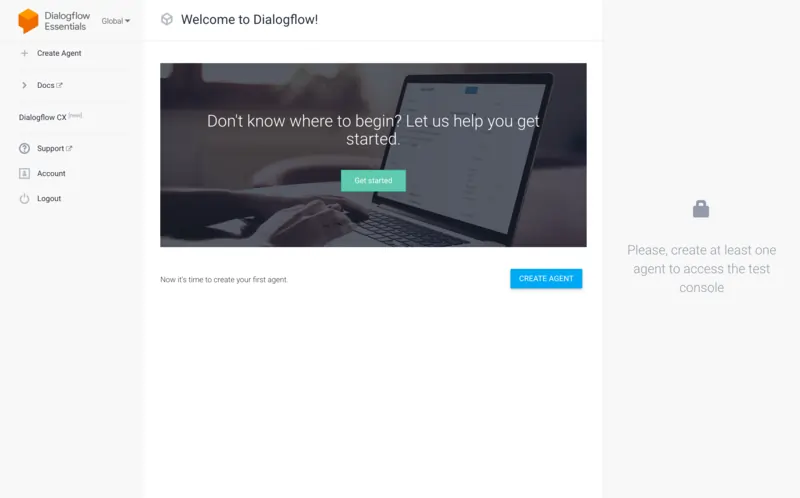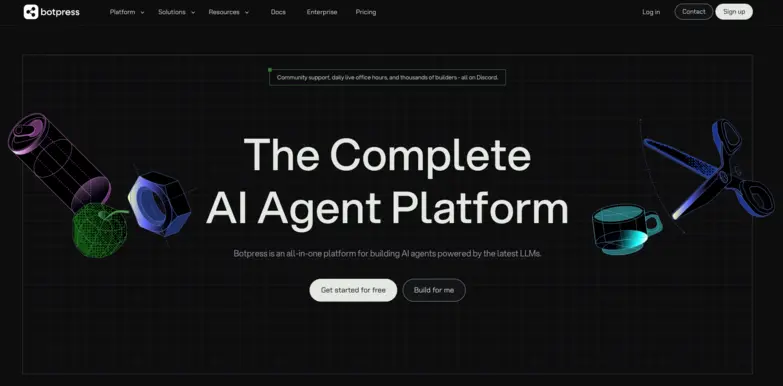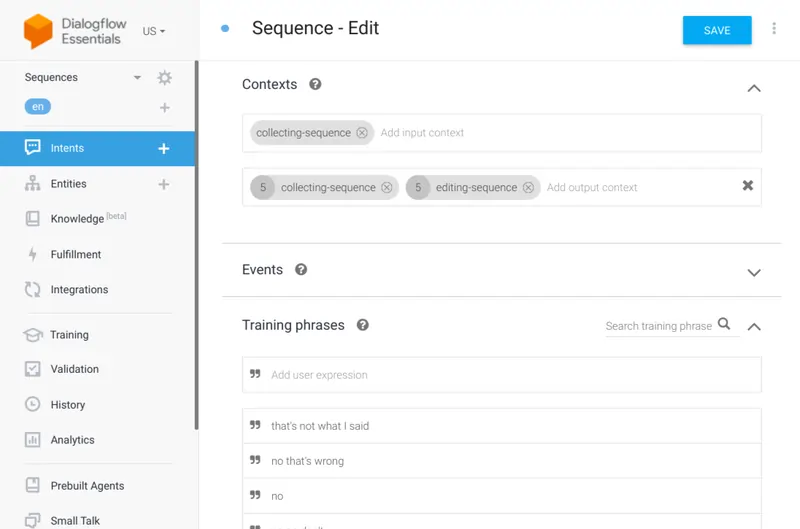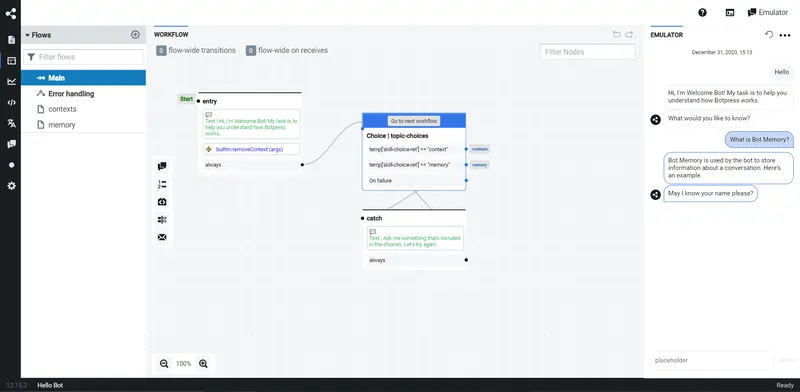Today’s businesses demand AI chatbots that not only understands intent but also integrates seamlessly with operations and scales effortlessly.
If you're exploring AI chatbot building platforms, you’ve probably come across Dialogflow ES and Botpress.
But how do they compare? And more importantly, which one fits your conversational AI strategy? Let’s dive into a side-by-side look at Dialogflow ES vs. Botpress.
Quick Overview: Dialogflow ES vs. Botpress
TL;DR: Dialogflow ES is for teams that want to build basic AI chatbots quickly, especially if they’re already in the Google ecosystem. Botpress suits teams that want more customization when building conversational AI agents for complex support scenarios.
Dialogflow ES is a natural language understanding (NLU) platform by Google that lets developers design conversational interfaces for apps, websites and voice assistants. It’s good for handling simple bot flows, especially for teams that want something quick to deploy and easy to integrate with Google Cloud or Firebase.

Botpress is a conversational AI chatbot platform designed to create sophisticated AI agents. With features like in-house retrieval-augmented generation (RAG) and multi-turn memory, Botpress enables the creation of AI agents that not only automate support but can drive product recommendations, onboarding, internal workflows, and more – all while being fully customizable and deployable on private infrastructure.

Feature-By-Feature Comparison
Dialogflow ES vs. Botpress Pricing Comparison
Dialogflow ES Pricing
Dialogflow ES uses a Pay-As-You-Go pricing model based on usage volume and specific features. While there is a free tier (Trial Edition) suitable for small projects and experimentation, production use requires the Essentials Edition, with the following sample costs:
- Text interactions: $0.002 per request
- Speech-to-text (STT): $0.0065 per 15 seconds of audio
- Text-to-speech (TTS): $4-16 per million characters
- Phone Gateway: $0.05-$0.06 per minute
- Sentiment Analysis: $0.25-$1.00 per 1,000 requests
This granular pricing can scale efficiently for smaller use cases, but costs may add up as usage grows. Ultimately, Dialogflow ES is well-suited for teams comfortable managing usage-based billing.
Botpress Pricing
Botpress offers a free plan that includes $5 in monthly AI credits. These AI credits act as a budget for powering smart features like knowledge retrieval and text rewriting in your bots.
Botpress also offers a Pay-As-You-Go option, which lets teams pay only for the AI usage they consume, making Botpress a cost-effective option for businesses.
In terms of paid plans, Botpress offers straightforward pricing tiers:
TL;DR: Dialogflow ES is a good fit for teams needing granular control within Google Cloud, while Botpress appeals to teams seeking scalable conversational AI with predictable pricing and full control over AI usage.
Integration Capabilities
TL;DR: Dialogflow ES offers 12 built-in integrations focused on Google services and select messaging platforms. Botpress supports 190+ integrations across platforms and makes it easy to build custom connections.
Dialogflow ES includes 12 native integrations, primarily focused on messaging channels and Google ecosystem tools. It also supports webhooks, allowing developers to connect to external APIs or services for more advanced scenarios. However, integration options beyond Google Cloud services typically require additional middleware or custom code. Dialogflow users can also extend connectivity via automation platforms like Make or Zapier, though this adds complexity.
Botpress provides 190+ pre-built integrations across a wide range of tools like CRMs, help desks, e-commerce platforms, databases, and communication channels. These include native integrations with platforms like Salesforce, HubSpot, Zendesk, Shopify, and more, diversifying use cases like syncing customer data, updating records, triggering workflows, or automating ticketing. Developers can also build custom integrations easily using Botpress's built-in support for API calls, making it straightforward to connect with internal systems or third-party services without relying on external middleware.
Security Features
Both Dialogflow ES and Botpress offer strong foundational security, but the source and scope of their features differ.
Dialogflow ES benefits from running on Google Cloud Platform (GCP), inheriting many of its advanced security and compliance capabilities such as encryption at rest, audit logging, and role-based access control. However, these features are not part of Dialogflow ES itself, but rather managed through GCP configurations.
Botpress is built to support larger enterprises and more varied use cases, including workflows that may involve sensitive or regulated data. As a result, Botpress provides a broader range of advanced security features and compliance options.
Here’s how Dialogflow ES and Botpress compare on security features:
Knowledge Capabilities
TL;DR: Dialogflow ES supports limited knowledge base functionality via beta features, mostly useful for static FAQ content. Botpress offers flexibility, connecting to diverse data types, APIs, and using advanced retrieval techniques.
Dialogflow ES includes a Knowledge Connectors feature (in beta), which allows the chatbot to respond to user questions by searching through uploaded documents, typically in HTML, CSV, or TXT format. This makes it possible to automate basic support use cases without building out full intent trees. However, it lacks fine-grained control, contextual awareness, or ranking optimization. The system does not support unstructured data beyond simple articles and cannot integrate with live or structured data sources like APIs or databases without external middleware and webhooks.
Botpress supports an advanced approach to knowledge access. In addition to importing static content like FAQs and documents, Botpress allows bots to connect to APIs, query databases, or parse structured and unstructured data such as JSON, CSVs, PDFs, or even web-scraped content. Its in-house retrieval-augmented generation engine enables bots to extract the most relevant information at runtime, and generate contextualized responses based on retrieved content. This allows teams to build bots that don’t just recite static answers but adapt to varied user questions and contexts.
Bot Complexity
TL;DR: Dialogflow ES is suitable for simple-to-moderately-complex bots with linear flows. Botpress is built for complex, multi-turn conversations and automation across varied business logic.
Dialogflow ES is ideal for small to medium-sized bots with relatively simple or moderately complex flows. It uses a flat intent structure, where each user input is mapped to an intent, and contexts are used to manage limited conversation memory and branching.
While it's easy to get started, maintaining complex flows – especially those with shared intents, conditional paths, or long multi-turn dialogs – become difficult. Features like form filling, state transitions, and reusable components are limited or require workarounds. Developers often face challenges scaling ES agents without duplicating logic or resorting to external orchestration.

Botpress is built to handle more options for customization with multi-turn dialogs, conditional logic, and custom workflows. It supports a graph-based conversation engine, allowing for reusable flows, nested conversations, and fine-grained control over state transitions. Botpress also enables memory across sessions and context switching mid-conversation. It’s well-suited for teams building agents that need to adapt behavior in real time.

Customization & Flexibility
TL;DR: For customization, Botpress stands out as one of the most flexible options on the market, giving teams full control over how their chatbots behave and integrate with other systems. Dialogflow ES offers backend flexibility but is limited when it comes to advanced customization.
Dialogflow ES lets developers add custom logic through webhooks, which can be hosted on services like Google Cloud Functions or Firebase. These webhooks allow the bot to connect to external systems and return responses. However, all complex logic must be handled outside the platform; there’s no built-in way to write or run code directly within Dialogflow. The conversation design is also more limited, with fewer tools for managing complex flows or reusing logic. Customizing the bot’s appearance or behavior inside the Dialogflow Messenger widget is minimal.
Botpress, on the other hand, gives teams full control over how their bots work. Developers can write custom code in JavaScript or TypeScript directly inside the platform, connect to APIs, and build advanced workflows. Botpress supports reusable components, real-time logic, and flexible memory handling, making it much easier to build smart bots. Teams can also fully customize the chatbot’s frontend and backend behavior to match their specific needs.
Memory
TL;DR: Dialogflow ES does not offer built-in memory across sessions. Botpress includes built-in memory that helps chatbots remember users and context over time.
Dialogflow ES can remember information over the course of a single conversation. But once the conversation ends, that memory is lost. If teams want the bot to remember user details between chats, they need to connect it to an external database or system using webhooks.
Botpress has built-in memory that works across sessions. The bot can keep track of past conversation, and personalize responses based on what it knows. Developers can decide what information to store, for how long, and how to use it.
Community & Support
TL;DR: Both Dialogflow ES and Botpress offer learning resources and documentation. Dialogflow relies on Google’s traditional support ecosystem, while Botpress adds a highly engaged developer community and hands-on support for all tiers.
At a baseline, Dialogflow ES and Botpress both offer structured learning tools, including documentation, tutorials, and product guides.
Dialogflow ES follows Google’s standard support model. Developers can access learning content through the Google Cloud Skills Boost platform, Codelabs, and YouTube tutorials. Dialogflow's official documentation is detailed and searchable, but live support is limited unless you're on a paid Google Cloud Support plan. Users can also get help through community forums like Stack Overflow and the Google Cloud Community, but these are not actively moderated by product experts.
Botpress, by contrast, offers a more hands-on support experience designed for developer teams at all stages:
- Live Chat Support is available for Plus plans and above
- Max, the AI Support Bot, provides instant answers and product guidance
- Customer Success Teams are included in Team and Enterprise plans
- A 30,000+ member Discord server offers peer support, community discussions, and daily live AMAs with Botpress experts
While Dialogflow ES offers structured learning backed by Google’s ecosystem, Botpress combines self-service education with real-time support.
Which platform is better for my business?
1. 24/7 Multilingual Support for a Global Travel Company
Key Problem: Providing 24/7 multilingual support across channels for a global customer base.
TL;DR: Dialogflow ES can handle multilingual queries and integrates with messaging apps, but Botpress offers stronger multilingual NLP and channel flexibility.
Amir leads customer support at a global travel booking platform. His team deals with time-sensitive inquiries like flight changes, cancellations, and travel advisories – often in multiple languages and across channels like WhatsApp, mobile apps, and the company website. Amir needs:
- A chatbot that can understand and respond in multiple languages
- Consistent experience across all platforms
- Ability to access real-time booking data and perform actions like cancellations or itinerary changes
Dialogflow ES supports over 30 languages and can detect user language to serve localized responses. Amir can deploy the bot on WhatsApp, Telegram, and web through built-in integrations, and connect it to back-end systems using webhooks. However, Dialogflow uses a flat intent structure, making complex multi-turn conversations or shared logic across languages harder to manage. Long-term memory is not supported, so personalizing conversations across multiple sessions would require external storage.
Botpress offers robust multilingual support (100+ languages) with control over localized content and NLU performance. It supports out-of-the-box integrations with web, WhatsApp, and custom channels, and allows Amir’s team to build flows that adapt based on language, location, or booking status. More importantly, Botpress bots can store user preferences and history between sessions, making it easier to offer personalized travel support without forcing users to repeat themselves. Botpress also offers predictable pricing tiers and a pay-as-you-go option, which makes it more cost-effective as Amir’s international support needs grow.
Ultimately, if Amir’s team needs flexible multilingual support with backend automation and personalization, Botpress offers stronger capabilities and the scalability required for a global travel platform.
2. Subscription SaaS Customer Support Scaling
Key Problem: A fast-growing SaaS company wants to deflect basic technical support and billing inquiries without hiring more agents.
TL;DR: Dialogflow ES supports quick setup for FAQ bots, but Botpress offers stronger integration and memory for fast-growing SaaS teams.
Sam is the Head of Support at a rapidly growing B2B SaaS company. His team handles a flood of tickets related to login issues, billing confusion, and onboarding questions. To keep up without hiring more agents, Sam needs:
- A chatbot that can answer repetitive technical and billing questions
- Easy deployment within Zendesk and Intercom workflows
- Backend integration with CRM and billing systems like Stripe or HubSpot
Dialogflow ES allows Sam to create bots that detect user intent and deliver scripted answers through Slack, web, or Messenger. Its webhook system lets the bot pull in info like subscription status or invoice history, provided Sam builds and hosts the fulfillment logic externally. However, without persistent memory, the bot can’t remember users or past conversations, which limits personalization.
Botpress, on the other hand, supports persistent memory and visual flow logic. Sam can integrate the bot with Stripe APIs to let users check their billing status or update payment methods. With JavaScript-based custom nodes, Botpress allows for full backend integration and real-time logic, all while fitting neatly into helpdesk workflows. It can even tag conversations for agent review or follow up with automated onboarding reminders.
For a fast-moving SaaS company looking to automate support while retaining flexibility, Botpress provides a more scalable, integrated solution.
3. Automated Order Management for a D2C E-commerce Brand
Key Problem: Automating post-purchase support like tracking, returns, and product questions.
TL;DR: Dialogflow ES works for basic post-purchase FAQs, but Botpress enables deeper automation with real-time order handling and product personalization.
Priya leads CX at a D2C e-commerce brand that just expanded internationally. Her team handles thousands of queries about order tracking, returns, and product details every week. Priya needs:
- A chatbot that can guide customers through returns and track orders in real time
- Seamless integration into Shopify and web chat
- Support for automating repetitive tasks like refund requests or FAQs
Dialogflow ES helps Priya get started fast. She can set up intents for return policies, shipping times, and product details, and use webhooks to fetch tracking updates. However, Dialogflow doesn’t include built-in memory, so returning users have to re-enter information. It also lacks a native workflow builder, so handling multiple steps like return validation followed by refund initiation, requires external logic and hosting.
Botpress gives Priya and her bot more capabilities. The bot can look up orders via Shopify’s API, confirm delivery status, or walk users through the return process. With built-in memory, the bot can remember user preferences or product categories from previous chats. Plus, Botpress supports custom flows and natural-language filtering for navigating large product catalogs. Botpress also makes sense for Priya’s team cost-wise: predictable monthly pricing for usage, integrations, and multilingual support keeps things budget-friendly during peak seasons.
For post-purchase support with real-time updates and automation, Botpress is a more flexible and cost-effective choice.
4. Heavily Regulated Industry Support (e.g. Healthcare)
Key Problem: Automating inquiries while meeting strict compliance and audit needs.
TL;DR: Dialogflow ES inherits strong security from Google Cloud. Botpress adds control with on-premise deployment, RBAC, and audit logs.
Marcus is responsible for customer experience at a healthcare provider. His team wants to automate scheduling, policy questions, and coverage info while staying compliant with HIPAA and regional data laws. Marcus needs:
- A secure chatbot that protects patient data
- Full audit logs and access control
- Option to deploy on-premise for compliance with internal security policies
Dialogflow ES runs on Google Cloud and supports HIPAA compliance (with a BAA), data encryption, and IAM roles. Audit logs and access control are available via Google Cloud’s broader infrastructure, but not from within Dialogflow itself. The bot must connect externally to schedule appointments or retrieve patient data, and persistent memory requires building and maintaining additional infrastructure.
Botpress, by contrast, includes audit logs, RBAC, and memory out of the box. Most importantly, Botpress can be deployed on-premise or in a private cloud, ensuring full control over sensitive data. Developers can build workflows like insurance eligibility checks or lab scheduling, while storing key details securely with encrypted memory.
In summary, for use cases requiring maximum security and deployment control, Botpress is better suited to meet enterprise compliance needs.
The Bottom Line: Botpress vs Dialogflow ES
Dialogflow ES and Botpress are both powerful AI chatbot building platforms but they’re designed with different use cases and levels of flexibility in mind.
Dialogflow ES is a good choice for teams that want to build intent-based conversational agents quickly, especially if they’re already using Google Cloud services. It’s ideal for handling straightforward FAQ flows or lightweight transactional bots across messaging channels.
Botpress is built for teams that want full control over their chatbot’s behavior and integrations. With built-in memory, workflow automation, and flexible pricing, Botpress is especially well-suited for companies scaling their support or building bots that go beyond basic Q&A.
FAQs
1. Which platform is better for voice-based assistants or IVR systems?
Dialogflow ES is better suited for voice-based assistants or IVR systems because it integrates natively with Google Assistant and supports telephony via the Dialogflow Phone Gateway, Twilio, and other SIP services. Botpress primarily focuses on text-based channels, and while it can be extended to voice with custom integrations, it lacks built-in voice assistant deployment features.
2. How steep is the learning curve for non-technical users on each platform?
Botpress, while offering a no-code visual builder, introduces more complexity with features like custom scripting, memory control, and workflow customization, making it more suitable for technical users or teams with developer support. Dialogflow ES has a gentler learning curve for non-technical users due to its intent-based interface, guided setup, and Google Cloud integrations.
3. Are there specific industry templates or pre-built bots available for either platform?
Dialogflow ES provides some pre-built agents in the Google Cloud console, primarily for common use cases like customer service, banking, and appointment booking. Botpress does not offer official pre-built templates but has a strong developer community and ecosystem where example bots, modules, and industry-specific projects are shared for customization.
4. Which platform offers better support for real-time collaboration between team members?
Botpress supports real-time collaboration features such as versioning, shared workspaces, and role-based access control, especially in its Team and Enterprise plans. Dialogflow ES relies on Google Cloud project permissions, but does not offer native collaborative features like live editing or branching within the Dialogflow console.
5. Can I white-label the chatbot interface with either platform for client delivery?
Yes, you can white-label the chatbot interface with Botpress, which allows full customization of the webchat UI and supports self-hosting for branding control. Dialogflow ES does not offer white-labeling out of the box for its Messenger UI and typically requires external frameworks or custom frontends to achieve full white-label deployment.
.webp)




.webp)

